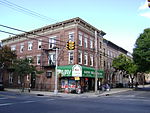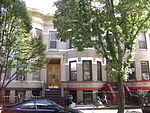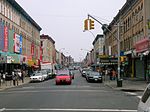Myrtle–Wyckoff Avenues station

The Myrtle–Wyckoff Avenues station (announced on New Technology Trains as Myrtle Avenue–Wyckoff Avenue station) is a New York City Subway station complex formed by the intersecting stations of the BMT Canarsie Line and the BMT Myrtle Avenue Line, served by the L and M trains at all times. It is located at Myrtle Avenue and Wyckoff Avenue in the Bushwick neighborhood of Brooklyn and the Ridgewood neighborhood of Queens (since Wyckoff Avenue between Gates Avenue and Eldert Street forms the border between Brooklyn and Queens). The complex is connected by a set of stairs and several elevators and escalators between the elevated and underground levels. The station was renovated completely from 2004 to 2008. Since many buses stop here, the MTA opened the Ridgewood Intermodal Terminal on August 20, 2010. Palmetto Street was shuttered to all traffic except for buses in order for the B26, B52, B54, Q55, and Q58 buses to terminate closer together on different parts of the street, and to increase accessibility and convenience for buses and subway transfers. However, neither the elevated BMT Myrtle Avenue Line nor the underground BMT Canarsie Line terminate here, merely the bus lines, excluding the B13, which passes on Gates Avenue, one street away from the terminal on Palmetto Street.
Excerpt from the Wikipedia article Myrtle–Wyckoff Avenues station (License: CC BY-SA 3.0, Authors, Images).Myrtle–Wyckoff Avenues station
Seigel Street, New York Brooklyn
Geographical coordinates (GPS) Address Nearby Places Show on map
Geographical coordinates (GPS)
| Latitude | Longitude |
|---|---|
| N 40.699511 ° | E -73.911166 ° |
Address
BMT Myrtle Avenue Line
Seigel Street
11206 New York, Brooklyn
New York, United States
Open on Google Maps





